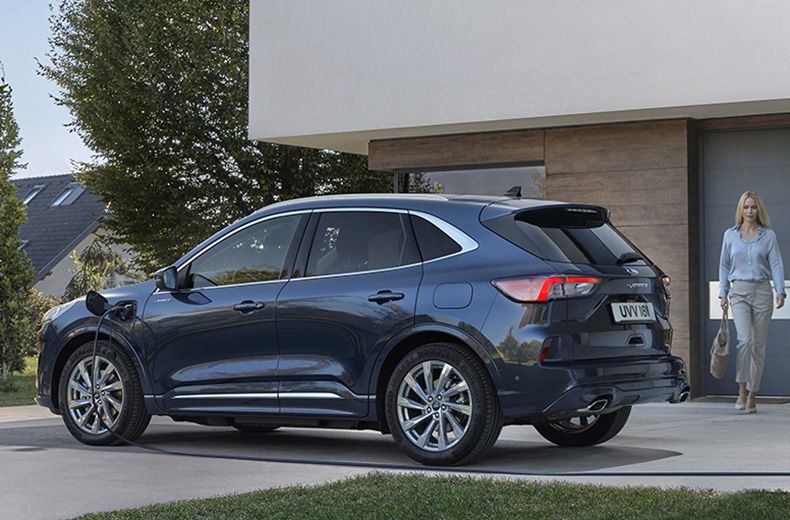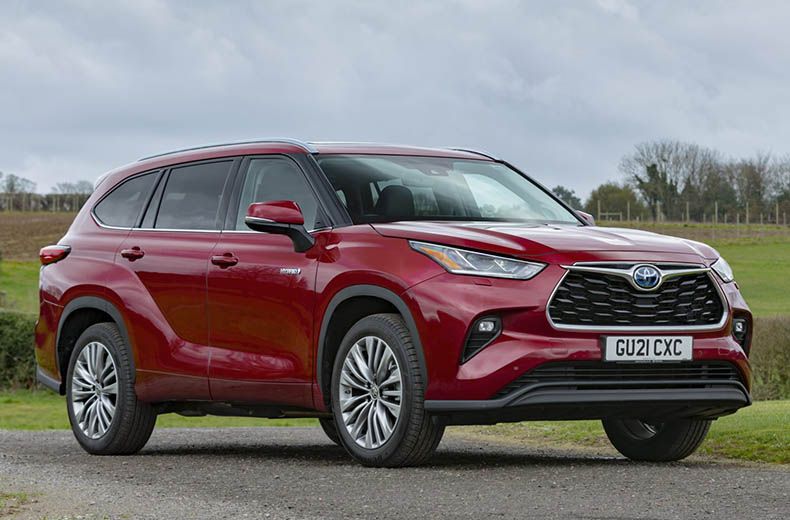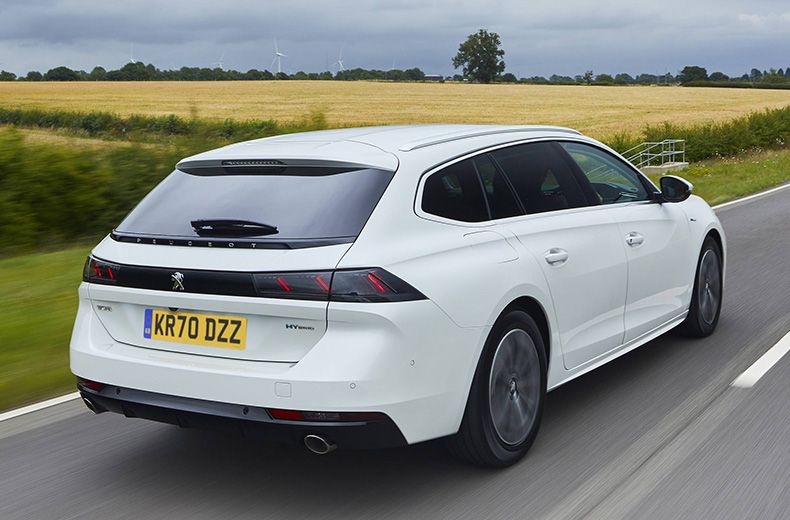Hybrids combine a petrol engine with an electric motor to boost efficiency. Standard hybrids use ‘self-charging’ technology that charges the battery as you drive, while plug-in hybrids can be recharged from the mains to allow a greater amount of all-electric running.
Plug-in hybrids are generally the more efficient option, but are also pricier to buy. They are also less practical for some drivers as their batteries need to be recharged from an electricity supply, and not everyone has access to a driveway.
Covering both types of hybrid, these are our top family car choices – including brands such as Audi, Kia, Peugeot and Toyota.
Estate hybrid family cars
Peugeot 508 SW Hybrid
This estate version of the Peugeot 508 has a larger boot than the saloon for enhanced practicality. Fold the rear seats and you’ll find 1,780 litres of space. Leave them up and 530 litres of luggage can be tucked behind the tailgate.
The 508 SW Hybrid is a plug-in hybrid (PHEV). Its 180PS petrol engine is combined with an 81kW electric motor and 11.8kWh battery for an all-electric range of up to 39 miles. When fitted with an on-board 7.4kW charger, the 508 SW Hybrid’s battery can be refilled in just under two hours using a 7.4kW home wallbox.
Like other Peugeots, the 508 uses the distinctive i-Cockpit interior layout. A 10-inch customisable digital driver’s display is standard, along with a central high-definition touchscreen of the same size. In the 508 SW Hybrid, this can show the flow of energy, driving modes and remaining range.
Read our Peugeot 508 Hybrid review.

Skoda Superb Estate iV
Superb by name, and certainly in terms of the space it offers, Skoda’s flagship has been spoiling families with commodious accommodation since 2001. Offered as a ‘fastback' hatch or estate in plug-in hybrid guise, the latter model carries up to 510 litres of cargo with the rear seats in place.
The ‘iV’ badge denotes Skoda’s plug-in technology, and the Superb Estate iV has a 1.4-litre turbocharged petrol engine connected to an 85kW electric motor and 13kWh battery. Total output is 218PS, with a muscular 250Nm of torque, and the car has an all-electric range of 35 miles. It can also travel up to 578 miles in one hit, thanks to the combined efforts of the petrol engine and hybrid batteries.
A hidden compartment beneath the boot floor is used to store the iV’s charging cables, while a choice of three drive modes allows owners to tweak the car’s character, from sporty to super-efficient.
Read our Skoda Superb iV review.

Toyota Corolla Touring Sports Hybrid
More than 20 years ago, Toyota kicked off the hybrid revolution when it launched the original Prius. This much-lauded petrol-electric technology has now filtered down to nearly all of the company’s cars, with the latest Corolla using hybrid powertrains as standard.
Toyota rather wishfully calls its Corolla estate the Touring Sports. More practical than its hatchback or saloon siblings, although certainly not sporty, the Touring Sports can carry five people and 520 litres of luggage with the back seats in place. Despite its more accommodating dimensions, it retains the sharp and distinctive styling of the 12th-generation Corolla.
Rather than needing to be plugged in, the Corolla is a ‘self-charging’ hybrid estate car. Its battery is charged by the petrol engine – there is a choice of either 122PS 1.8-litre or 183PS 2.0 units – and through regenerative braking. This feeds kinetic energy back into the battery, creating electricity to help power the car.
Read our Toyota Corolla Touring Sports review.
Premium estate hybrid family cars

Audi A6 Avant 50 TFSI e quattro
Audi’s electrified car range continues to expand, and the A6 Avant TFSI e quattro (‘Avant’ means estate in Audi-speak) uses the same plug-in hybrid powertrain as its saloon sibling. That means a 2.0-litre petrol engine and an electric motor, alongside a 14.4kWh lithium-ion battery.
Total power is 299PS, fed through Audi’s latest quattro all-wheel-drive system. On-demand technology means 4WD is only used when needed, so fuel economy is optimised. There is up to 41 miles of electric range, and CO2 emissions are as low as 30g/km.
As befits an Audi, quality, and technology inside the A6 are both first-rate. A 10.1-inch touchscreen controls the navigation system, which uses data to plan your route with the maximum mileage in EV mode. And while your children listen to the 10-speaker sound system, their luggage can be accommodated in the 405-litre boot.
Read our Audi A6 Avant 50 TFSI e quattro review.

Mercedes-Benz C-Class Estate C 300 e
Think of upmarket car brands and Mercedes-Benz is surely near the top of the list. Cars that wear the three-pointed star have always felt a cut above, and while the C-Class is one of the smallest estate cars from Stuttgart, it still majors on comfort and luxury.
A plug-in hybrid (PHEV), the C 300 e’s 204PS 2.0-litre petrol engine is joined to a 95kW electric motor and 25.4kWh battery. Total power output is 313PS. Impressively, there is up to 65 miles of all-electric range, but the curved rear bodywork means the boot can only accommodate 390 litres with the back seats in place. That’s no bigger than some hatchbacks.
Elsewhere in the interior, though, you’ll be well and truly wowed by the stylish 12.3-inch digital instrument display and central 11.9-inch touchscreen. Speaking of style, if you want more of it, Mercedes-Benz also offers a plug-in hybrid version of its CLA Shooting Brake estate.
Read our Mercedes-Benz C-Class Estate review.
- Electric car charging – how it works and how much it costs
- Make EV charging easier with the RAC home charge point installation service
- What are the benefits of electric cars?

RAC Breakdown Cover
Limited Time Offer
*£7 a month for new, single vehicle Basic cover. ^For 1 nominated vehicle when added to Extra or Complete cover. New customers only. Ends 29/04/24. 7am.

5-seat SUV hybrid family cars

Ford Kuga PHEV
Now reinvented and as popular as ever, the Ford Kuga SUV now offers a much wider choice of models – including hybrid and plug-in hybrid models.
The plug-in Kuga PHEV’s 2.5-litre petrol engine, electric motor and 14.4kWh battery produce a total of 225PS. In a similar way to other plug-in hybrids, a choice of driving modes allows you to use electric power or the petrol engine.
You can also combine both power sources, or engage the engine to charge the battery for times when you prefer to drive quietly and with no emissions. The car’s all-electric range is 37-39 miles.
A home wallbox can charge the battery in as little as three hours: useful for when the Kuga is used near-constantly to ferry the family. This efficient SUV is relatively practical, too – its boot holds an adequate 412 litres with the rear seats up, or 1,481 litres when they’re folded down.
Read our Ford Kuga PHEV review.

Hyundai Tucson Hybrid
With more than seven million examples shifted since it debuted in 2004, the Tucson is Hyundai’s best-selling SUV. The latest version certainly stands out, with its sharp creases and headlights that bleed into the front grille. It’s a daring and distinctive look. Inside, a large driver display and slick touchscreens give a high-tech feel.
Offering up a wide choice of electrified powertrain options, the Tucson is available with hybrid and plug-in hybrid options, in addition to petrol and diesel engines. The regular hybrid has a 1.6-litre petrol engine, a 44.2kW electric motor and a 1.49kWh battery for a system output of 230PS.
Despite its striking appearance, the Tucson isn’t just about style. Its boot can carry a family-friendly 616 litres of luggage with the rear seats up. Fold them down and this swells to 1,795 litres – more than enough for a summer holiday away.
Read our Hyundai Tucson Hybrid review.

Kia Niro HEV
The Kia Niro has been a big success for the South Korean car maker. Kia’s second biggest-selling model in the UK, the original car won many friends with its range of hybrid (HEV), plug-in hybrid (PHEV) and all-electric (EV) models.
This latest model offers a similar degree of diversity, but has edgier and quite futuristic styling. Inside, it’s a similar story, with more premium-looking materials and technology, such as the haptic dual-panel display to control the air conditioning and infotainment system. It’s borrowed from the larger and more expensive EV6 electric car.
The Niro HEV beats the plug-in hybrid when it comes to practicality, its 451 litres of space trumping the PHEV’s 348 litres. Powered by a 1.6-litre petrol engine and a 32kW electric motor, its six-speed dual-clutch automatic gearbox is smooth and quiet, giving the Kia a relaxed and refined feel on the road.
Read our Kia Niro review.
- Best plug-in hybrids 2022
- Electric vehicle range – how far can I drive in an EV?
- RAC Charge Watch – The cost of charging an electric car at a public charger
7-seat SUV hybrid family cars

Kia Sorento HEV
The fourth-generation of Kia’s large SUV has seven seats as standard and is a core part of the company’s ‘Eco’ model range. This includes 10 cars that feature hybrid, plug-in hybrid, or electric power.
The Sorento is offered with diesel, hybrid, or plug-in hybrid powertrains. The hybrid requires no external battery charging as it harnesses braking energy to ‘self-charge’ its 1.49kWh battery pack. A 1.6-litre petrol-hybrid engine develops 229PS, sent to all four wheels by a six-speed automatic gearbox.
The roomy and upmarket interior boasts luxuries such as a 12-speaker Bose sound system, head-up display, panoramic sunroof and 360-degree parking cameras as standard. The Sorento’s seven seats can also be folded in many permutations. Lie them all flat and you’ll liberate 821 litres of luggage space. The second-row backrests can even be folded electrically via a switch in the luggage area.
Read our Kia Sorento review.

Toyota Highlander Hybrid
Introduced in 2021, the Highlander takes a well-known Toyota name used in many overseas markets. In the UK, it is a seven-seat SUV powered by the company's tried-and-tested ‘self-charging’ hybrid technology.
Using an intelligent all-wheel-drive system, this large SUV can fit all the family and its paraphernalia inside a very spacious cabin. There is 268 litres of luggage space with seven seats in place, or a huge 1,909 litres when loaded to the roof with all the rear seats folded. The second row of seats can also slide forwards or backwards by 180mm.
The Highlander’s 248PS hybrid powertrain combines a 2.5-litre petrol engine with two electric motors and a nickel-metal hydride battery. It can cruise on electric power at up to 78mph, and run on batteries alone for short periods. The biggest Toyota SUV also has a two-tonne towing capacity – ideal if you own a caravan, horsebox or boat.
Read our Toyota Highlander Hybrid review.
The RAC is leading the way when it comes to supporting drivers in the switch to electric vehicles.
A growing number of our patrol vans have built-in emergency mobile charging systems that can give an out-of-charge electric car enough power to be driven a short distance home or to a working charge point.
Find out more about RAC EV Boost.
Our All-Wheels-Up recovery system also allows our patrols to rescue electric cars safely with no need for a flatbed.
Find out more about RAC Electric Car Breakdown Cover.
RAC Breakdown Cover
Join the RAC and get breakdown cover. Our patrols fix 4 out of 5 vehicles on the spot, with repairs done in just 30 minutes on average.











